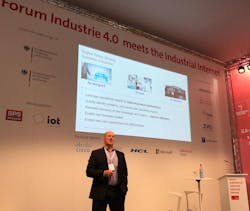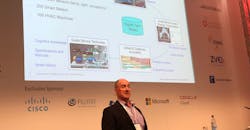At Hannover Messe Fair 2018, the world of the Internet of Things (IoT) came to life like never before. In my three years attending the show, this is the first year I feel like the IoT has become real-world applicable. Companies and customers are no longer talking theoretically but approaching the subject with real products, solutions, and methods.
Such an example is the digital twin. While not a new concept, the advances in the IoT have made it more attainable. Now, anyone who collects data on their system can design and implement the digital twin. IBM Watson CTO Sky Matthews showcased the latest related trends and technologies, and how new IoT advances are pushing it forward.
IoT Enabling the Digital Twin
The concept of the digital twin has been around since 2001. It was introduced by Dr. Michael Grieves at the University of Michigan.
The reason why the concept is now garnering attention is that the IoT has made it practical and applicable. The world of IoT has introduced mass data accumulation along with faster computing.
There are three major changes that are driving the digital twin today:
- Velocity: The rate at which data can be gathered has increased under IoT. Sensing equipment and faster-connected networks have made it easy to acquire large amounts of real-time data.
- Resolution: It isn’t just the amount of data but also the quality of the data. The level of detail available now is greater, providing a clearer picture of the physical assets (e.g., devices, hardware, and physical systems).
- Learning: The rise of machine learning allows systems to learn from the data. Digital twins can interpret from the collected data and help engineers to calibrate the model to reflect real-world scenarios.
How Do We Define the Digital Twin?
The digital twin offers several benefits for designers. It leverages operational insights to improve product performance. It can identify problems, root causes, and the eventual impact on the systems. It sometimes is able to predict these problems before even a single aspect of the system is built or assembled.
The digital twin can improve efficiency via automation discovery of new knowledge and insights. Lastly, it creates new business models, user experiences, and differentiation.
To break down what the digital twin is, here are the definitions of its five dimensions:
- Model: The digital twin can be composed of separate models that have different aspects. The components that live within the different models provide data to generate the digital twin.
- Interface: This is how the user interacts with the twin. Depending on the user, there may be different interaction methods or visualizations. For example, one may interact with a simulation, the raw analytic data, predictive maintenance notifications, or system reports.
- Analytics: The analytics of the system is how the data and the value of the digital twin are extracted and interpreted. A digital twin incorporates data from different data sources. The analysis is done via advanced computer systems which include machine learning and artificial intelligence.
- Lifecycle: The representation of the digital twin changes depending on where it is in the lifecycle. Most products start with engineering specifications, representing the potential prototype. As the overall system grows and more models are incorporated, it becomes more complicated as each component is replicated digitally. The collection of data created through the lifecycle is called the digital thread.
- Granularity: The scope of the digital twin can be a small component or a large complex system. The granularity is the range of detailed specifications of either system.
Real-World Digital Twin Examples
At the conference, Matthews displayed the digital twin model of a cognitive building.
The environment included 600 room sensors, 250 smart meters, and 169 HVAC machines. The sensors included temperature readings, light sensors, and occupancy monitoring. The building sensors provided data that allowed for the creation of operational models, building models, and weather predictions.
Those models helped inform engineers on how to regulate the building's energy consumption and to detect the potential building use cases of the HVAC system.
The end result provided technicians with guided service, maintenance procedures, and cognitive knowledge of the building’s climate control.













